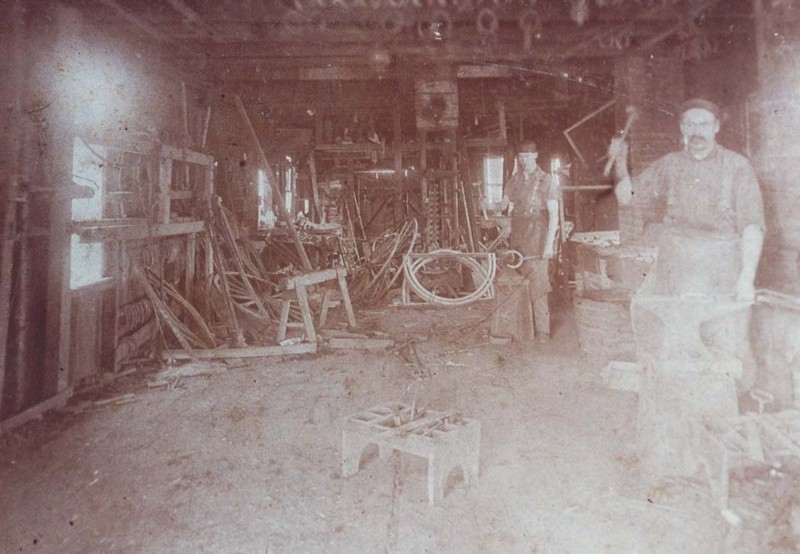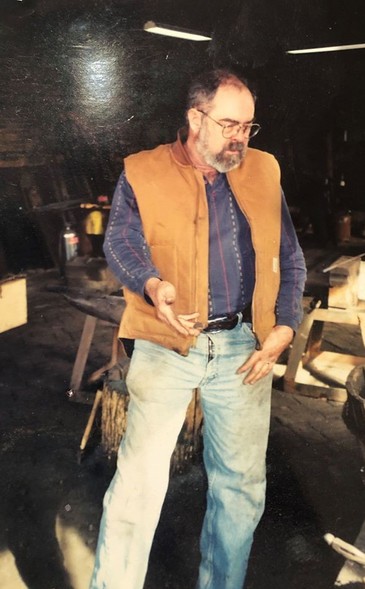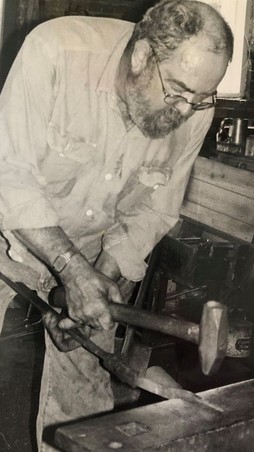Blacksmithing on the Prairie
Introduction
Text-to-speech Audio
Images
Old Interior



Charlie Keller, Museum Employee, was instrumental in acquiring the Chesebro collection and curating this exhibit space.

Charlie Keller- Exhibit Volunteer

Backstory and Context
Text-to-speech Audio
Blacksmiths were an important part of cities and towns in the early 1900s. Repairing or sharpening whatever needed attention was their business. So was shoeing horses, painting buggies, repairing stoves, or mending wash tubs. This work allowed farmers to farm, wives to cook, and keep house, and everyone else got their jobs done.
A.B. Chesebro opened his Blacksmithing establishment after 1888. Ralph and Elmer Chesebro learned the trade from their father, and after his death in 1909, ran the shop until the 1920s. They lived in Saunemin, Livingston County, Illinois.
There were 12 similar shops in Champaign and Urbana in 1910. Among them were the Chester Transfer Co., located at 58-60 South First Street, F.M. Foltz, at 206 North Market St., and Gerber & Sigler, 203 East Main in Urbana.
Industrialization after World War I reduced demand for Blacksmithing. When the Chesebro business closed in 1920, the building sat undisturbed for almost 20 years.
In 1992, Pat and Nina Chesebro donated the contents of their father Ralph's shop to the Early American Museum. Tongs were still hanging by the forge, horseshoes were on the racks, and buggy rims still in their packing. In 1992, the building was 58 feet long and 25 feet wide. The front portion held the Blacksmithing space which was 34 feet long. Large double doors opened to the west. Two forges, benches, bins, and several windows were on the south side. An open central area furnished space for vehicles and machines being repaired. Rings in the north wall allowed horses to be tied while being shod. A partition with a large sliding door separated the wagon shop from the Blacksmithing area. This 24 foot long and 25 foot wide space held the wood, working equipment, and buggy and wagon repair facilities. A gasoline engine sat in one corner of the wagon shop to power the line shaft which drove all machinery in the building.
The museum staff moved over 2,000 artifacts from the shop and brought them here. What we know about the shop and its business comes not only from examining the tools but also from the day books, orders for supplies, and other records, which came to the museum. Most important of all were the oral histories of Pat and Nina about growing up while living next to the Blacksmith's shop.
"We played in the shop, but not when work was going on. When Dad was working, we would go down and watch. I can remember watching the trip hammer and pounding things on the anvil and with the new shop we had these hitching racks out front. We used to do stunts on them, and finally Dad put one in our yard." -Nina Cheseboro
In the exhibit hall, you will find "The Trick Buggy." This buggy was built by Parry Manufacturing Company and owned by the Trick Family of Sydney, IL in the late 19th century. Any repairs to the buggy would have required the services of a Blacksmith. To make a tire for a buggy, Blacksmiths required a measuring wheel to create the correct size. Blacksmiths needed a special outdoor oven to heat the tire iron. An intense fire made with wood shavings provided the heat necessary to soften the iron so it could be dropped into a wooden wheel. While the iron was hot, Blacksmiths hammered and "quenched" the hot iron with water to prevent singeing the wood. This would also shrink the iron, making it fit the wheel tightly on the rim.
